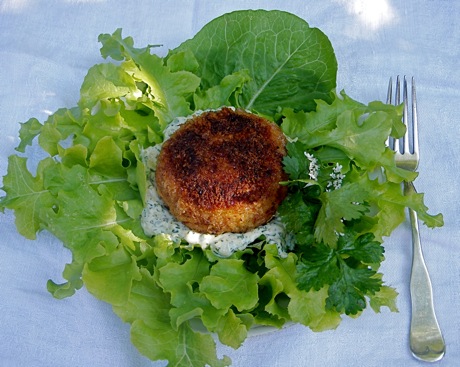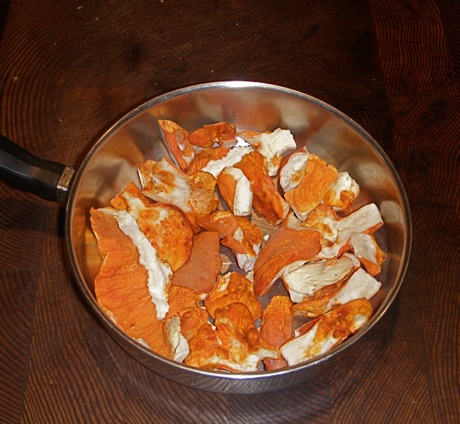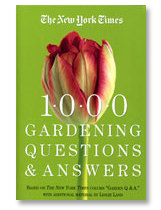Maine Crab and Lobster (Mushroom) Cakes – with Cilantro Nectarine Mayonnaise
At the risk of jinxing things I have to say this is shaping up as a boffo mushroom year (in Midcoast Maine, anyway.) We haven’t had much chance to go out, but when we do we are finding things, including lobster mushrooms, which seem to be unusually abundant.
I am of the school that feels they get their name from their brilliant color. To me, the flavor is meaty, not fishy. But others claim they also taste faintly crustaceanlike. This isn’t as farfetched as it sounds; mushroom cell walls are primarily composed of chitin, the same material that makes crab and lobster shells.
Either way, they have a great affinity for Maine crabmeat, one of the world’s greatest seafoods.
Maine Crab and Lobster Mushroom Cakes
For 4 roughly 3-inch cakes, rich enough to be dinner for 4 if there’s something else fairly substantial on the menu:
4oz. lobster mushrooms, weighed after cleaning (see below), enough to make @1 cup cooked and chopped*
8 oz. Maine crabmeat
2 tbl. thick homemade mayonnaise, half olive oil and half peanut oil*
½ tsp. chopped capers, or more to taste
½ tsp. minced lovage, or more to taste – omit if you don’t have any
1 cup panko
1 lemon
1 egg
2 tbl. butter
peanut oil for shallow frying
1. Put the pieces of cleaned lobster mushroom in a shallow pan just large enough to hold them in one layer. Pour in water to come up a scant ¼ inch. Bring to a simmer, cover the pan and cook until the mushrooms are fully cooked; they will look translucent.
2. There will be some liquid in the pan, how much depending on mushrooms, pan shape etc. Remove mushrooms with a slotted spoon, boil liquid until it’s reduced to thick syrup, then lower heat, replace mushrooms and cook, stirring, until there is no free liquid. Turn off the heat. Let the mushrooms cool in the pan.

cooked lobster mushrooms being chopped (I forgot to shoot them when they were still in large pieces).
3. Chop the mushrooms into roughly quarter-inch chunks, big enough to taste , small enough to blend with the crabmeat. Mix with crabmeat, mayonnaise, herbs and a pinch of salt. Taste and adjust seasonings.
4. Put the panko on a plate and grate the lemon zest over it. Toss with your fingertips to mix. Beat the egg in a shallow bowl. Set out a wire rack to hold the cakes.
5. Divide the mixture in 4 parts and form each into a patty about ½ inch thick. Pressing firmly should be enough to have it (barely) hold together. If necessary, bind with a bit more mayonnaise.
6. As each patty is formed, put it in the beaten egg and turn – gently! – to coat. Place it on the panko. When all the cakes have been formed, coat each heavily with the panko, turning and pressing to get a thick, even covering.
As each is completed, put it on the rack, then let them sit at least half an hour to firm up. (Refrigerate if you must hold them longer than about 75 minutes, then let come back to room temperature before cooking.)
7. Melt the butter over medium heat in a shallow pan large enough to hold the cakes without crowding. Add enough oil to make a layer @ ¼ inch thick. When the oil is hot, add the cakes and fry, turning once, until both sides are richly browned, about 5 minutes a side. Drain briefly on paper towel or newspaper, then serve with
Cilantro Nectarine Sauce for Crabcakes
For about 1 3/4 cups:
1 cup thick thick homemade mayonnaise, half olive oil and half peanut oil*
2/3 cup finely minced cilantro
1 very ripe small white nectarine, peeled and chopped to pulp, @ 1/2 c. pulp
1 tsp. lemon juice, or more to taste
pinch of salt
Mix thoroughly, taste. Adjust lemon and salt.
*Substitutions:
Actual lobster can be used instead of the mushrooms, but it will of course elbow aside the more delicate crab.
Commercial mayo – Hellman’s, please – is ok, but it’s thinner, sweeter and more aggressively flavored than the homemade kind. This will make more difference in the sauce than in the crab cakes themselves. Be ready to correct with more lemon juice and maybe choose a slightly less ripe nectarine.
Preparing Lobster Mushrooms
The first thing to know is that lobster mushrooms (Hypomyces lactifluorum) are really lobsterized mushrooms. The color, flavor and texture are all created when a parasitic mushroom – the Hypomyces – colonizes another mushroom.
The host may be any of several species of Russula or Lactarius, but their individual traits are overwhelmed by the lobsterization. From the culinary point of view, all that’s left is the shape and sometimes not even that.
As the process proceeds, the host becomes yellowish, then orange, then flaming red, then flaming red with burgundy weepings. Flavor and texture are best at the orange stage. Red is alright if and only if the mushroom is firm and the inside is white when you cut into it. Anything soft or discolored ( brown or grey) is decaying and should be discarded. **
The next thing to know is that lobster mushrooms are often extremely dirty.

Freshly picked lobster mushrooms. Notice the dirt. Know that there is a lot more dirt inside the funnels and inside the inside creases.
So step one is wash the mushrooms. We’ll save the discussion of whether one should wash mushrooms for another day. Suffice it to say there are some mushrooms that must be washed and if you don’t think lobsters are among them please don’t invite me to dinner.
The most flavor conservative way to wash is to cut the mushrooms as necessary to expose the dirt, brush off all that can be brushed off, then immerse the pieces one by one in a bowl of tepid water and gently rub off what remains.
Now you have a bunch of wet mushroom parts. Put them on paper towel and let them dry for an hour or two. You can use them damp in recipes where they will be immersed in liquid; let them dry thoroughly if they will be sautéed.
Loosely wrapped in waxed paper, lobster mushrooms keep well refrigerated, both before and after washing – IF you let the washed ones dry thoroughly before putting them away. Don’t be alarmed by white bloom that forms on the surface or shows up on the waxed paper; that’s just the spores, reminding you that the mushrooms are rapidly maturing and should be used up promptly.
** To be absolutely safe, you should know what the host species is, in the unlikely case it’s one that should not be eaten. Out here in reality, once hypomization is well underway, there’s no way to identify the host without lab equipment, so you have to proceed at your own risk, something I have been doing for more than 30 years.
As the authoritative Milk Mushrooms of North America (Bessette, Harris and Bessette, Syracuse University Press, 2009) puts it “Hypomyces lactifluorum is a very popular edible mushroom even though the identity of the host species is usually undetermined.” The only poisoning Bill has ever dealt with in all his years of consulting came not from the lobster mushrooms per se, but from the fact that the mushrooms in question were rotten.
Photography note: The first time I tried to photograph the cakes it was at night, with predictably dreadful results. (So far I draw the line at learning about lighting).
But there were serious deficiencies in the styling, too. No matter what I did, here were these intractable dark brown disks with pale, light-reflecting sauce. Mayo on top – no good; on the side – better; underneath – probably the best solution but then there was this naked hockey puck that looked very silly crowned with a spring of cilantro.
So before trying again in daylight I googled crab cake images, hoping to kite off some useful ideas and you know what? Nobody can photograph crab cakes, at least nobody in the first 60 offerings, after which I gave up.




















What an informative blog and the nectarine puree in the sauce sounds fascinatingly fetching.
Those mushrooms look just as delectable as I gather they are, and I love the idea of nectarines and cilantro for the sauce!
These sound delectable!
I gather morels here in Ohio in the spring, but haven’t ventured into any others.
Will the lobster mushrooms survive drying for preservation?
What a wonderful-sounding flavour combination! Here in the Australian winter, I feel a trillion miles away!
This recipe is a wonderful reentry point for me into your garden and cooking- I have loved the 3000 Mile Garden for over a decade and found your blog while doing a “I wonder whether…” google to find YouTube clips of the tv version. This is an even better discovery! Looking forward to poking around 🙂 Thanks!